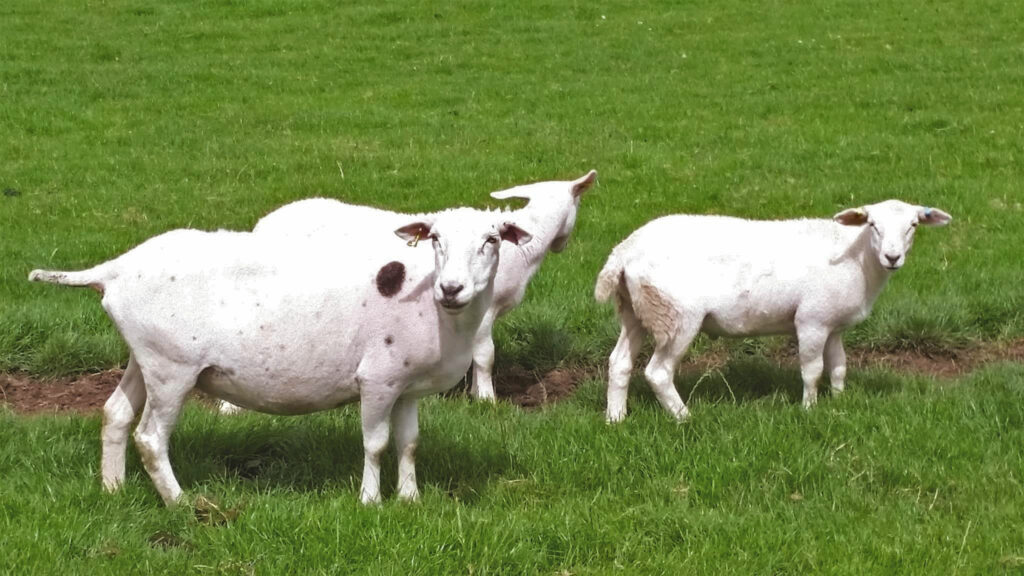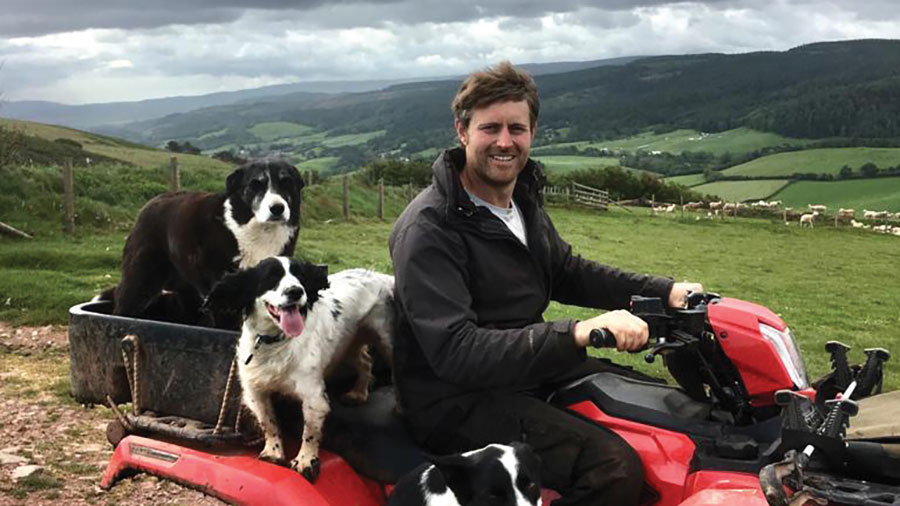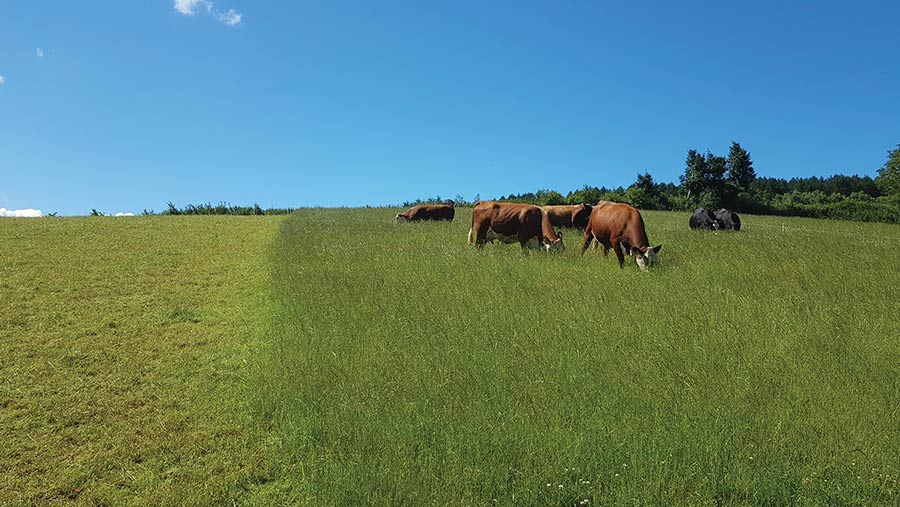Switch to wool-shedding sheep benefits Exmoor farmer
 © David Knight
© David Knight The purchase of a small number of Wiltshire Horn ewes to graze some coastal ground for the Higher-Level Entry Scheme led Exmoor farmer David Knight to change his whole flock to a wool-shedding breed and adopt a rotational grazing system.
Mr Knight, who farms 348ha (860 acres) of mainly permanent pasture and 243ha (600 acres) of rough, coastal ground at Wydon Farm, Minehead, with his father and brother, says it was this move that set the wheels in motion to think about how he could make his farm more sustainable.
Farm facts
- 900 Exlana ewes
- 100 Hereford and Angus suckler cows
- 220-280 cattle in total
- Cattle finished deadweight for ABP
- Half the cows outwintered on dry hill ground
- Early flock lambed in February and late flock in April with lambs sold via Cutcombe market through a collection scheme
- Cattle calve outside in May/June
- Ewes and cows are set stocked for lambing/calving
- Brassicas grown as winter feed for ewes, with plans to grow more to finish lambs
“When I bought the 30 Wiltshire Horns, which are natural wool shedders, 10 years ago, it was only with the intention of grazing the coastal ground. Although they were feral creatures and not the best ewes, they are brilliant wool shedders, and it was a trait we liked,” he explains.
See also: Welsh farmers tap into niche market with ‘new’ breed of lamb
Mr Knight then decided to look at introducing the wool-shedding Exlana breed to his flock of 650 Exmoor and Suffolk Mules.
He has been putting Exlana rams onto his Exmoor Mules and retaining the crosses for breeding, growing the flock to 900 Exlana ewes. He says it takes about two crosses for the ewes to become complete wool shedders.

David Knight © David Knight
Those which do not shed are moved into the early-lambing flock and not retained for breeding.
Data and electronic identification (EID) is proving to be a useful tool when it comes to breeding replacements. Ewes are weighed two to three times – at weaning, midsummer, and before tupping – so they can be managed appropriately, and lambs are weighed every two to three weeks from weaning onwards.
“We do not castrate any of our ram lambs anymore, so it is important we monitor them, so we can ensure they are always moving forward. We get better growth from entire ram lambs,” he says.
Benefits of wool shedding
Switching to wool-shedding animals alone has made a significant difference to the farm’s viability, says Mr Knight. Benefits include:
- Halving the amount of pour-on that is required – a saving of £1,200 across the whole flock. He used to administer a spring and autumn dose, but now only an autumn dose is used to protect against ticks on the farm.
- Almost eliminating cast sheep issues. Mr Knight says cast sheep were a “phenomenal” problem on the farm before moving to the Exlana. “Some years we were losing numbers into double figures, and that was with checking them at least twice a day, due to the high local numbers of crows and ravens,” he explains. “If you add in the time it took to check them, fuel, vehicle wear and tear, and then the number of sheep we lost and the cost of rearing their orphaned lambs, it soon added up.”
- Saving £1.30 a ewe in shearing costs. Although a small number of sheep still need still need to be shorn – as they are keeping a lot of first crosses to expand the flock – most do not. “This year with the dire wool price it really brought it home how important this saving is. It confirmed we made the right decision.” Less shearing and crutching also mean reduced handling, which is saving on labour.

Cattle follow the sheep, grazing down long pasture © David Knight
Adapting grazing management
A change in breed also led to a change in grazing management, with Mr Knight moving away from set-stocking in favour of an intensive, rotational grazing system.
“The Exlana can use grass well, as well as being exceptional browsers of other plants, so since changing the breed, we have also changed the way we graze.”
The farm was mapped out by Precision Grazing and the Knights have invested in water pipes and mobile fencing to make the stock graze more evenly.
Sheep are now grazed in paddocks of 0.4-2ha (1-5 acres), depending on time of year, stock class and desired outcomes. Cattle are used as “pasture managers”, following the sheep and grazing down long pasture.
All main flock ewes are now lambed outside in April, thanks to the better grazing management and the change in the breed.
Although the move to better grass use is helping sheep get more from grass, Mr Knight accepts he has more work to do to bring down his feed bill.
Feed costs
It costs him about £10 a head to finish lambs from the early-lambing flock. He lambs two flocks – one in February and the rest in April. Lambs from the early flock are finished from May to July, and sold via a collection scheme through Cutcombe Market.
Early lambs are fed about 25kg a head of creep to get them finished early and weighing 38-44kg. “It costs us £250/t and in total about £10 a lamb to get the early lambs away.
The idea is to get this down, so we are less affected by outside influences such as feed costs, while still achieving the important outcome of getting those early lambs off the farm before we typically dry out.”
Mr Knight has also been feeding whole oats to ewes, which has helped reduce the feed bill. “We used to use feed blocks, but these are incredibly expensive at about £500/t [£9 a ewe], but buying in whole oats has reduced the cost to £170/t [£4 a ewe].”
They are feeding a slightly higher tonnage of oats through Advantage Feeders.
Alternative feed
Plans are in progress to grow alternative sources of feed. This year he has established 4ha (10 acres) of forage rape.
He says: “We are just dipping our toe in the water with brassicas. This will provide a feed to fill the midwinter gap for our ewe hoggs. Depending on how this goes, the plan will be to grow some brassicas, such as kale, to finish lambs or winter ewes.”
The farm also gets very dry in midsummer, so the Knights are looking to introduce chicory, plantain and clover mixes into the swards, to help improve drought tolerance and provide additional protein.
